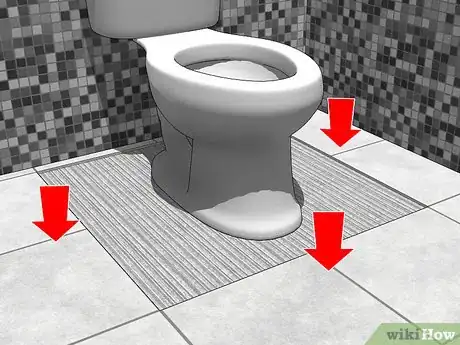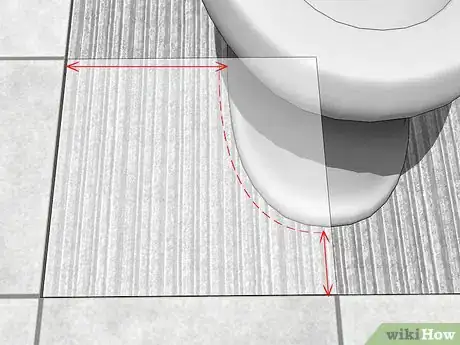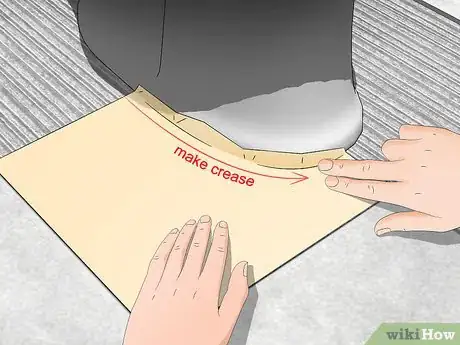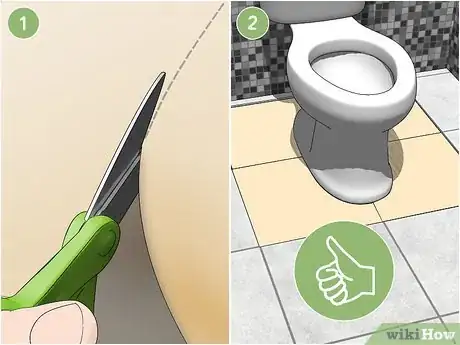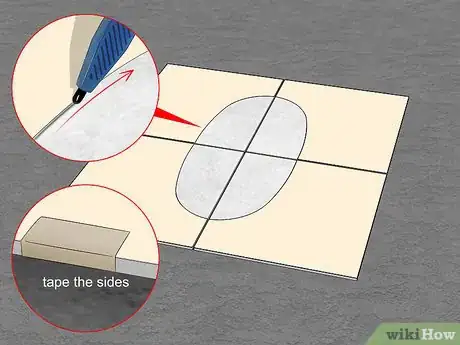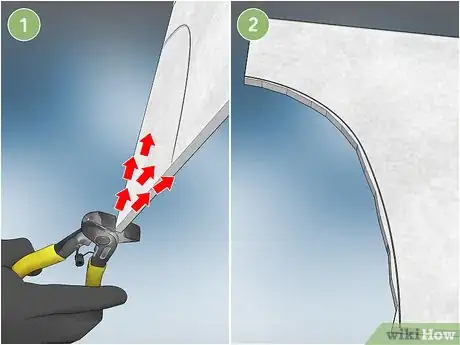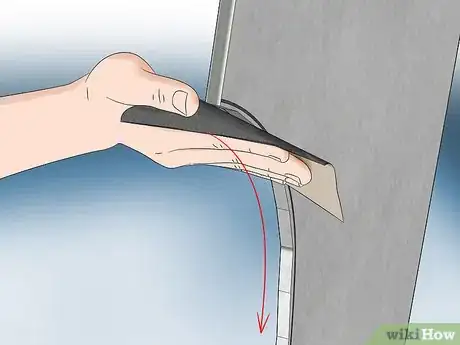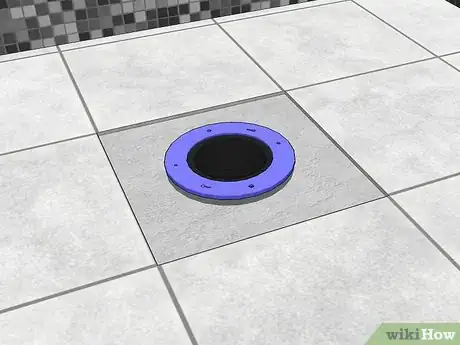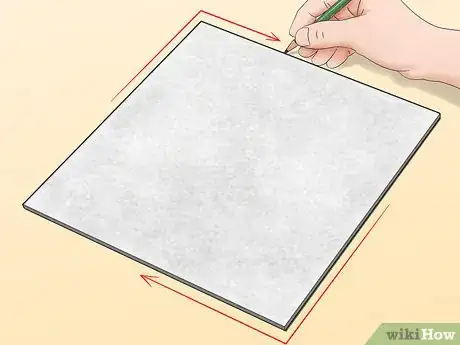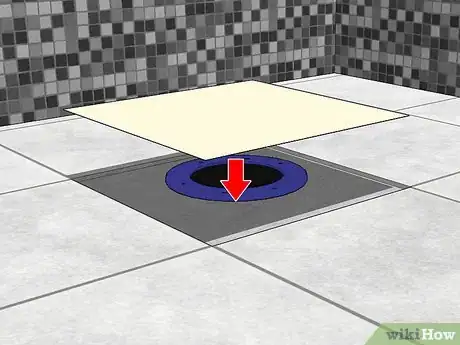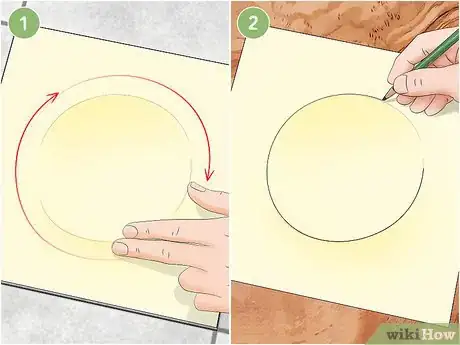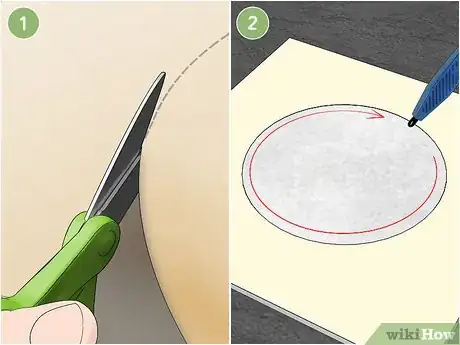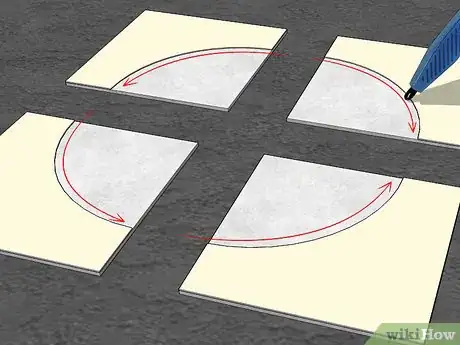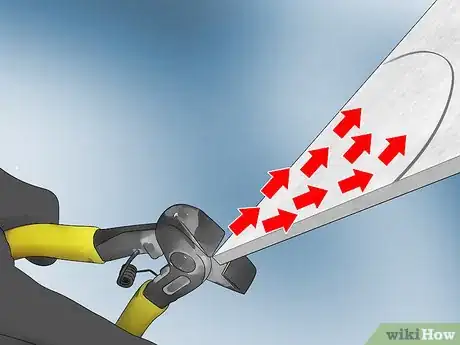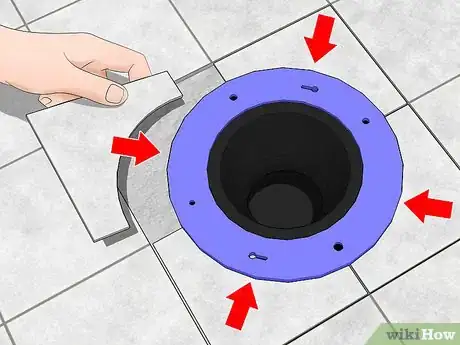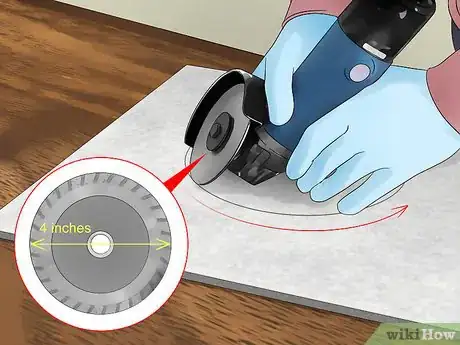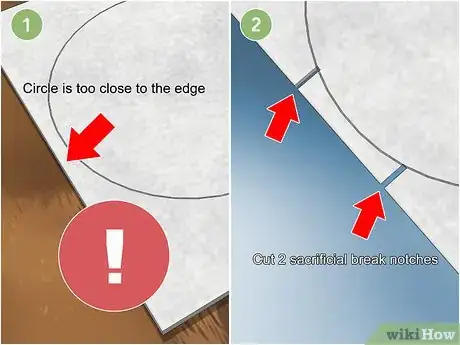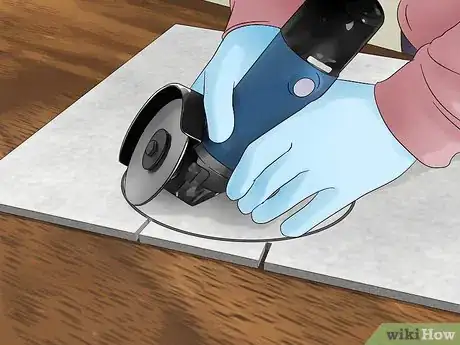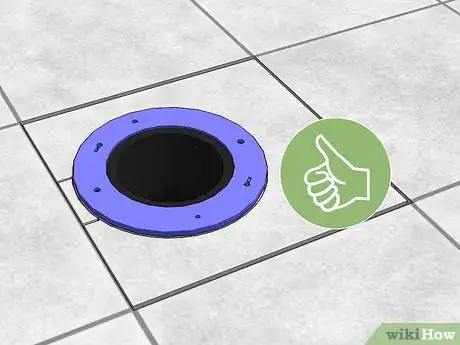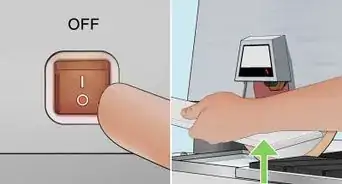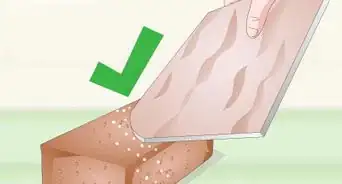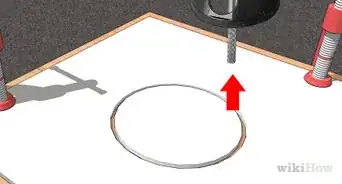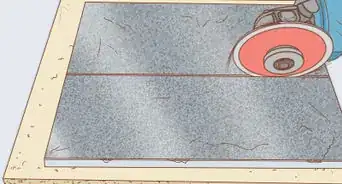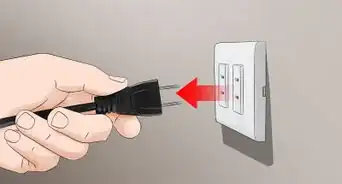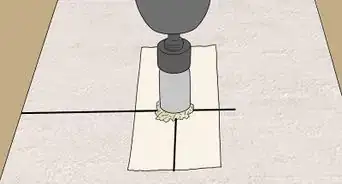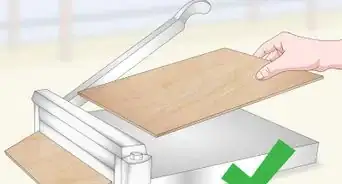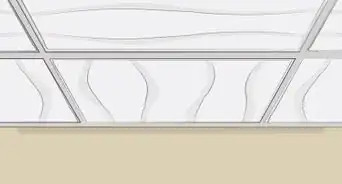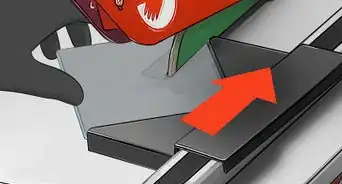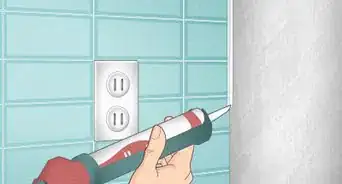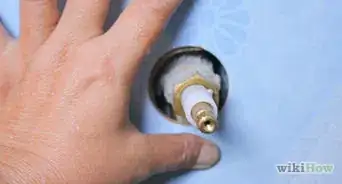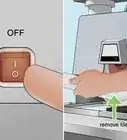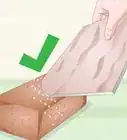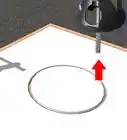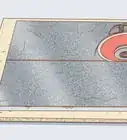This article was co-authored by Agustin Renoj and by wikiHow staff writer, Christopher M. Osborne, PhD. Agustin Renoj is a Home Improvement Specialist with Renoj Handyman based in the San Francisco Bay Area. With over 18 years of construction experience, Agustin specializes in carpentry, painting, and exterior, interior, kitchen, and bathroom renovations. Renoj Handyman is a family-owned business that consists of craftsmen trained in all areas of construction.
There are 16 references cited in this article, which can be found at the bottom of the page.
This article has been viewed 102,301 times.
If DIY tasks like replacing a toilet and installing a tile floor are within your skill set, then you can also handle tiling around a toilet. Cutting tiles to fit neatly around the base of an installed toilet requires careful template-making and tile-nipping, however, so patience and precision are critical. In most cases, you'll have more room for error if you remove the toilet, trace and cut one or multiple tiles to fit around the toilet flange, and then reinstall or replace the old toilet.
Steps
Tracing and Cutting Tiles Around an Installed Toilet
-
1Install the full tiles surrounding the toilet first. Take your time planning out your tile pattern and creating grid lines on the subfloor so that you need to make as few angular/circular tile cuts as possible. When you're tiling around an already-installed toilet, plan out your pattern so that at there is at least 2 in (5.1 cm) of space between the base of the toilet and the edges of any of the tiles you'll be laying around it.[1]
- You'll usually save time (due to a greater margin for error with your tile cuts) if you remove the toilet, tile the floor, and then reinstall or replace the toilet. However, tiling around an existing toilet may be preferable in some cases.
- Tiling around an installed toilet is easier if the base rests flush against the wall behind the toilet. If you have to tile all the way around the base, including the small space between it and the wall, strongly consider removing the toilet, tiling around the toilet flange, and reinstalling the toilet.
-
2Create sheets of paper that are the same size as a whole tile. Simply cut the paper to match the size of the tile—for instance, 16 by 16 in (41 by 41 cm). Cut one sheet for each tile you'll need to lay around the base of the toilet.[2]Advertisement
-
3Estimate your tile cuts and cut parallel slits in the paper in these areas. Visualize how each tile will fit around the toilet base, and estimate which parts of each tile will need to be cut away. Transfer these estimates to the corresponding sheets of paper, and use scissors to cut parallel slits that are about 0.25 in (0.64 cm) apart in the areas that will need to be removed. When doing so, it's better to overestimate the area that will need to be removed than to underestimate.[3]
- For instance, imagine that you have a toilet with an angular base that will necessitate cutting a triangular section away from one of the corners of one of your tiles. You'd cut the parallel slits into that same area of the corresponding sheet of paper, with a little extra “wiggle room” added to your cuts.
-
4Lay each sheet into place and crease the slits along the toilet base. One at a time, lay the sheets of paper down where their corresponding tiles will go, remembering to account for spacing between tiles due to grout lines. The slits will fan up and over the installed toilet's base. Use your finger to press a crease into each slit—one at a time—where the subfloor meets the toilet base.[4]
- When you're done, you'll have created an accurate template for that tile. Then you can move onto the next sheet of paper.
- To account for future grout lines, utilize the same plastic spacers that you use when permanently setting the tiles in place.
-
5Cut the slits along the traced lines and dry-fit the sheets. Once you've creased all the sheets of paper, take your scissors and cut carefully along the crease lines. Then, lay all these cut sheets of paper down around the toilet (again, accounting for grout lines) and make sure they fit snugly against the toilet base. If one or more do not, get more paper and repeat the process.[5]
- You want the finished tiles to rest right up against the base of the toilet, so take your time to make sure the paper templates fit precisely.
-
6Tape the sheets to the tiles, then trace and scribe the cut lines. When all the paper templates are just right, tape each one to a tile and use a pencil to transfer the cut pattern. After that, remove the paper and use a tile scribe to score 0.125 in (0.32 cm) deep lines into the tiles, tracing right over top of the pencil lines.[6]
- Tile scribes can look like thick pencils or come in other shapes. Look for them at hardware stores or online.
-
7Remove the unneeded tile with tile nippers. Slowly and carefully squeeze the handles to snip away small “bites” of tile from the sections that need to be removed. Turn your small “bites” into tiny “nibbles” as you get to the score lines. If you try to snip off too much, you risk breaking the tile and having to start over.[7]
- Tile nippers look and work like giant fingernail clippers, and are an essential tool for any tile job. Standard nippers will cut ceramic and porcelain tiles, but you may want to use specialty nippers for glass tiles or fragile stone tiles (like slate).
- Wear safety glasses so shards of tile don't get into your eyes, and sturdy work gloves to protect your hands from sharp tile edges.
-
8Smooth the cuts with a tile file and wipe the tiles down. Once you've finished cutting a tile with the tile nippers, use the tile file to sand down any rough edges along the cut. Follow this up with a damp cloth to wipe away any dust. After this, dry-fit the tile to make sure it rests snugly along the toilet base. If it doesn't, keep nipping, or get a new tile and start again if necessary.[8]
- When all the tiles have been cut, filed, cleaned, and dry-fitted, you can move on to setting them in place permanently.
Tracing Tile Cut Lines before Toilet Installation
-
1Tile the areas away from the toilet flange first. When tiling a bathroom, mark out your desired grid pattern on the floor, and lay tile over the unobstructed areas first. Don't tile around the toilet flange—the circular piece that connects to the drain pipe and upon which the toilet itself will rest—until the end.[9]
- Draw out a grid pattern for the tile layout on paper, and then on the subfloor itself, that reduces the number of tile cuts you need to make. If you're using larger tiles—e.g., 12 by 12 in (30 by 30 cm) or larger—you may be able to cut a circle out of a single tile to go around the flange.
-
2Cut one or more sheets of paper that match the size of your tiles. If you need to cut 1 tile to go around the flange, cut 1 sheet of paper; if you need 4 tiles, cut 4 sheets of paper. Be as precise as possible in sizing the sheets of paper properly.[10]
- For instance, if your tiles are 8 by 8 in (20 by 20 cm), cut your sheets of paper to those dimensions.
-
3Lay the sheet(s) of paper in place, overlapping the flange. Place the sheet(s) of paper exactly where the tile(s) will go, making sure to account for the spacing of your grout lines. That is, if your other tiles are spaced 0.125 in (0.32 cm) apart due to the grout lines, leave this same gap between the set tiles and your paper.[11]
- You can employ the same plastic spacers you use when laying the tile to make sure your grout line spacing is consistent with your paper templates.
- If you only need to cut a single tile, just lay a single sheet of paper right over the flange.
-
4Trace the outline of the flange onto the sheet(s) of paper. First, run your finger along the outline of the flange to create a crease in the paper. Then, lift up each sheet and use a pencil to trace an outline that's slightly—about 0.25 in (0.64 cm)— larger than the creased outline.[12]
- The tracing doesn't need to be perfect, because the toilet will rest on top of the flange and the cut tile(s) and hide any minor errors.
- If you have a removable flange and want it to rest on top of the tile(s) instead of on the subfloor, make the pencil tracing about 0.5 in (1.3 cm) smaller than your crease outline instead. That way, the outer rim of the flange will rest on the surrounding tile(s).[13]
-
5Cut out the flange circle and trace it onto the tile(s). Use scissors to cut the sheet(s) of paper to the correct shape, then tape the sheet(s) onto the tile(s). Transfer the cut lines onto the tile(s) with a pencil, then remove the paper.[14]
- Don't discard the paper yet—you'll need it again if you break a tile while cutting it!
Cutting Multiple Tiles before Toilet Installation
-
1Score the cut lines with a tile scribe. A tile scribe is a small, sharp hand tool that etches a cut line into the tile. This etching helps make sure the tile snaps where you want it to instead of breaking or cracking elsewhere. The scoring only needs to be 0.125 in (0.32 cm) or so deep.[15]
- You can get a tile scribe at any hardware store or online.
-
2Use tile nippers to clip away the excess tile. Think of tile nippers as industrial-strength fingernail clippers. Start at the corner of the tile that's being cut away, and squeeze the handles together to make the top and bottom blades take small “bites” out of the tile. Start “nibbling” more carefully as you approach the scored line.[16]
- Standard tile nippers will work with practically every kind of tile, although some natural stone tiles (like slate) may be too fragile. Consult your tile supplier if needed. You can also use specialty tile nippers for glass tiles or other particular types.
- Be careful not to nip one of your fingers while you work. Wear work gloves to protect your hands from cut tile edges and safety glasses to protect your eyes from snipped shards of tile.
-
3Make sure your cuts are correct by dry-fitting the tiles. Because the toilet base will cover the cut tile edge, your cuts don't need to be perfect. However, take the time to dry-fit the tiles in place to make sure your cuts are generally accurate—ideally, no more than 0.5 in (1.3 cm) larger than the flange.[17]
- Use plastic spacers to account for your grout lines when dry-fitting the tiles.
- If you're going to rest a removable toilet flange on top of the installed tiles, remember to remove it before dry-fitting (and later, when laying the tile!).
- If your dry-fit lines up properly, you're ready to set these tiles in place in the same way you did the rest of the floor.
Cutting a Single Tile before Toilet Installation
-
1Use an angle grinder to score the circular shape into the tile. Attach a 4 in (10 cm) diamond wheel blade to the grinder, and position it so the circular blade is at roughly a 45-degree angle to the tile. Slowly work your way around the circle traced into the tile, using very light pressure. You only need to score the tile about 0.125 in (0.32 cm) deep on this initial pass.[18]
- Use caution at all times. Tie back long hair and remove any dangling jewelry, and wear long sleeves and safety glasses. The grinder will kick up a lot of dust, so wear a dust mask and consider buying a vacuum attachment that you can connect to your grinder.
- Angle grinders are an affordable and useful small power tool you can find at any hardware store. Diamond blades are more expensive than other blades you can get for the grinder, but they cut through tile much better.[19]
-
2Cut sacrificial break notches if the circle is near the tile's edge. If there is less than about 1.5 in (3.8 cm) of space between your traced circle and an edge of the tile, there's a good chance the tile will break while cutting it. If this is the case, use the grinder to cut 2 or more deep score lines (about halfway through the tile) that run from the perimeter of the circle to the closest edge of the tile.[20]
- The goal is to have the tile snap at these chosen, controlled spots, instead of randomly.
- Straight, short, controlled breaks in the tile will be barely noticeable once you set the tile in place, especially since the toilet will be resting on top of it.
-
3Continue grinding around the circle with gentle pressure. Once you've finished scoring the tile surface and creating any sacrificial break notches, keep making slow, steady passes with the grinder at a 45-degree angle. If the tile breaks at the sacrificial points, remove that section and keep cutting. Eventually, you'll grind your way through the tile and have the circular cutout that you need.[21]
- Don't try to cut more than about 0.125 in (0.32 cm) deep with any single pass, or the tile will probably break in a random spot and you'll have to start over.
- Be as precise as possible but remember that the circle you cut doesn't need to be perfect. The actual cut line will be covered by the toilet base.
-
4Dry-fit the tile over the flange to make sure it fits. Check your work before you attempt to secure the tile in place permanently. So long as your circular cutout is less than 0.5 in (1.3 cm) larger than the toilet flange all the way around, the base of the toilet should cover the cutout.[22]
- Once you know the tile fits properly, you can secure it to the floor permanently.
Expert Q&A
Did you know you can get expert answers for this article?
Unlock expert answers by supporting wikiHow
-
QuestionHow do you make sure the tile around your toilet looks good?
 Agustin RenojAgustin Renoj is a Home Improvement Specialist with Renoj Handyman based in the San Francisco Bay Area. With over 18 years of construction experience, Agustin specializes in carpentry, painting, and exterior, interior, kitchen, and bathroom renovations. Renoj Handyman is a family-owned business that consists of craftsmen trained in all areas of construction.
Agustin RenojAgustin Renoj is a Home Improvement Specialist with Renoj Handyman based in the San Francisco Bay Area. With over 18 years of construction experience, Agustin specializes in carpentry, painting, and exterior, interior, kitchen, and bathroom renovations. Renoj Handyman is a family-owned business that consists of craftsmen trained in all areas of construction.
Home Improvement Specialist Don't rush through the cutting process. You want to avoid breaking your tile, so you need to take your time. You should also invest in a good quality diamond blade, which is a blade specifically for cutting tile. Also, when you're laying the tile, make sure you don't put too much pressure on it, as it can be very fragile.
Don't rush through the cutting process. You want to avoid breaking your tile, so you need to take your time. You should also invest in a good quality diamond blade, which is a blade specifically for cutting tile. Also, when you're laying the tile, make sure you don't put too much pressure on it, as it can be very fragile. -
QuestionHow do you cut peel and stick tile around a toilet?
 Drew Hawkins1Community AnswerLay the sheet of peel-and-stick tile around the toilet. Use a pencil to mark the areas you need to trim in order to make it fit. Use a utility knife or a pair of sturdy scissors to cut along the line that you marked. Fit the tile around the toilet to make sure it's properly trimmed before you try to stick it in place. If it needs to be trimmed a little more, use your pencil to mark a line and then cut along the line. Once the tile is trimmed to fit, you can remove the paper backing to expose the adhesive underneath. Then, carefully press the sticky side down and smooth out the surface with your hands so there aren't any trapped bubbles.
Drew Hawkins1Community AnswerLay the sheet of peel-and-stick tile around the toilet. Use a pencil to mark the areas you need to trim in order to make it fit. Use a utility knife or a pair of sturdy scissors to cut along the line that you marked. Fit the tile around the toilet to make sure it's properly trimmed before you try to stick it in place. If it needs to be trimmed a little more, use your pencil to mark a line and then cut along the line. Once the tile is trimmed to fit, you can remove the paper backing to expose the adhesive underneath. Then, carefully press the sticky side down and smooth out the surface with your hands so there aren't any trapped bubbles. -
QuestionHow do you install tile around a toilet?
 Drew Hawkins1Community AnswerGo ahead and install the full tiles surrounding the toilet first, leaving the space around the toilet open. Plan out your pattern so that at there is at least 2 in (5.1 cm) of space between the base of the toilet and the edges of any of the tiles you'll be laying around it. Cut pieces of paper to match the size of your tile and place the paper against your toilet so you can see where you need to cut it order to make it fit. Mark on the paper with a pencil where you need to cut. Then, transfer the marking to a tile and use tile nippers to trim the tile to fit the markings on the paper. Trim as many tiles as you need using the paper method so they fit exactly.
Drew Hawkins1Community AnswerGo ahead and install the full tiles surrounding the toilet first, leaving the space around the toilet open. Plan out your pattern so that at there is at least 2 in (5.1 cm) of space between the base of the toilet and the edges of any of the tiles you'll be laying around it. Cut pieces of paper to match the size of your tile and place the paper against your toilet so you can see where you need to cut it order to make it fit. Mark on the paper with a pencil where you need to cut. Then, transfer the marking to a tile and use tile nippers to trim the tile to fit the markings on the paper. Trim as many tiles as you need using the paper method so they fit exactly.
Things You'll Need
- Tile scribe
- Tile nippers
- Tile file
- Angle grinder with diamond blade
- Eye protection
- Pencil, paper, scissors, and tape
- Damp cloth
References
- ↑ https://www.wickes.co.uk/how-to-videos/tiling-flooring/tile-around-toilets, video @ 0:15
- ↑ https://www.wickes.co.uk/how-to-videos/tiling-flooring/tile-around-toilets, video @ 0:30
- ↑ https://www.wickes.co.uk/how-to-videos/tiling-flooring/tile-around-toilets, video @ 0:40
- ↑ https://www.wickes.co.uk/how-to-videos/tiling-flooring/tile-around-toilets, video @ 0:50
- ↑ https://www.wickes.co.uk/how-to-videos/tiling-flooring/tile-around-toilets, video @ 1:00
- ↑ https://www.wickes.co.uk/how-to-videos/tiling-flooring/tile-around-toilets, video @ 1:15
- ↑ https://www.wickes.co.uk/how-to-videos/tiling-flooring/tile-around-toilets, video @ 1:40
- ↑ https://www.wickes.co.uk/how-to-videos/tiling-flooring/tile-around-toilets, video @ 1:40
- ↑ https://www.wickes.co.uk/how-to-videos/tiling-flooring/tile-around-toilets, video @ 0:15
- ↑ https://youtu.be/slkeqsFBB0k?t=1m5s
- ↑ https://youtu.be/slkeqsFBB0k?t=1m5s
- ↑ https://youtu.be/slkeqsFBB0k?t=1m5s
- ↑ https://youtu.be/T2zEggf6mYI?t=3m10s
- ↑ https://youtu.be/slkeqsFBB0k?t=1m5s
- ↑ https://www.wickes.co.uk/how-to-videos/tiling-flooring/tile-around-toilets, video @ 1:25
- ↑ https://www.wickes.co.uk/how-to-videos/tiling-flooring/tile-around-toilets, video @ 1:40
- ↑ https://www.wickes.co.uk/how-to-videos/tiling-flooring/tile-around-toilets, video @ 2:00
- ↑ https://youtu.be/Gx-Kx71-ANI?t=10s
- ↑ Agustin Renoj. Home Improvement Specialist. Expert Interview. 13 January 2021.
- ↑ https://youtu.be/Gx-Kx71-ANI?t=1m25s
- ↑ https://youtu.be/Gx-Kx71-ANI?t=2m05s
- ↑ https://youtu.be/Gx-Kx71-ANI?t=2m30s
About This Article
If you have some DIY experience and you know how to tile a floor, you should be able to tile around a toilet using paper templates. All you’ll need is sheets of paper, tape, a scribing tool, and a tile file. You’ll need to install the full tiles surrounding your toilet, leaving a square where your toilet is. Then, cut sheets of paper to the same size as your whole tiles and cut them to the shape you need. Remember to leave a little extra space for grout. Once you’ve got the right shapes, you’ll need to tape the paper templates to your tiles and cut them with a scribing tool. If the edges of your tiles are too rough, smooth them out with a tile file or sandpaper. For more tips, including how to cut tiles to go around your toilet before it’s installed, read on!
